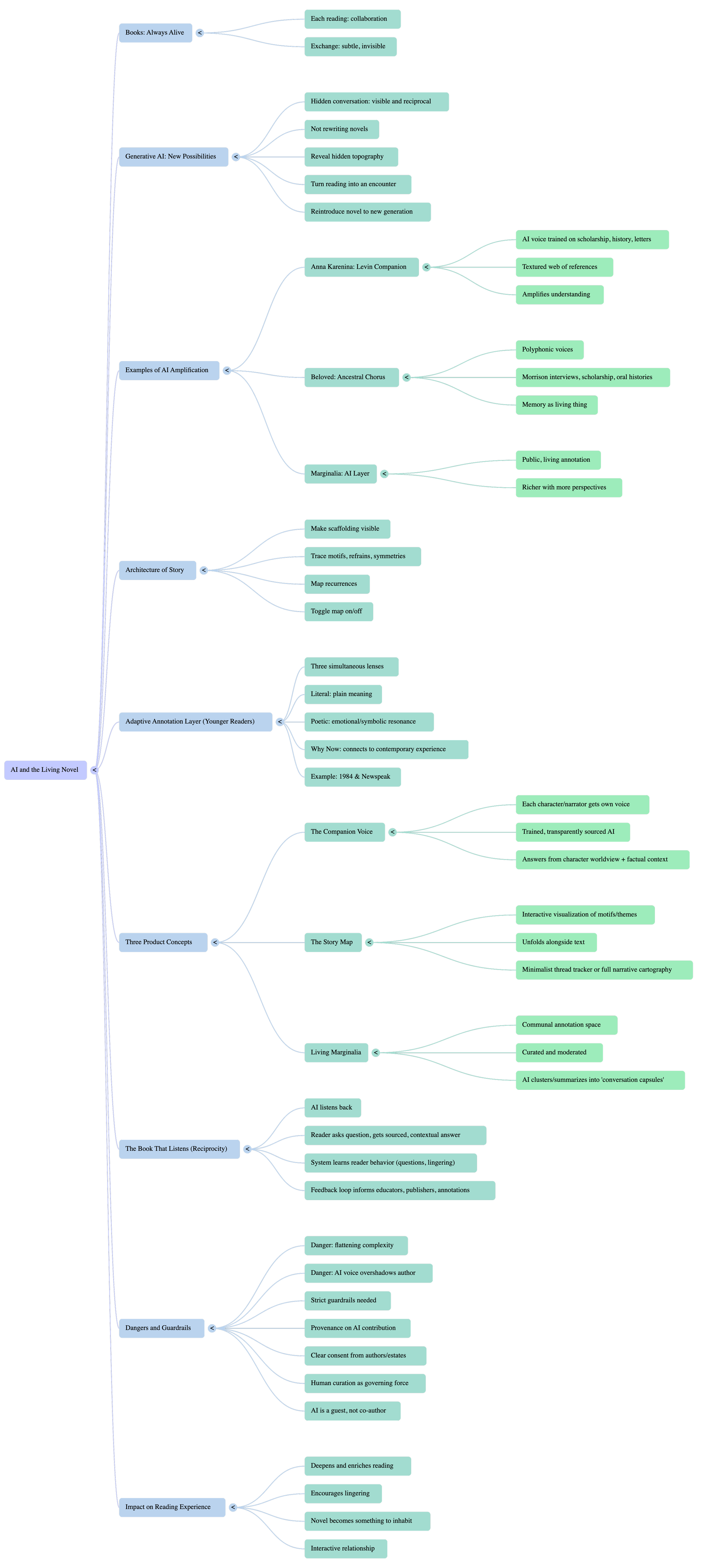When the Book Talks Back: How AI Might Turn Novels into Living Conversations
Books have always been more alive than we admit. Yet we pretend they’re still, inert things. Paper bricks waiting patiently on a shelf. But the truth is they’ve always been in motion. Each reading is a collaboration, a meeting point between a fixed text and a shifting reader. You bring what you’ve lived; the book brings what it has stored. The exchange is subtle, invisible, and, until now, largely untraceable.
Generative AI offers the possibility of making that hidden conversation visible. And, for the first time, reciprocal, without collapsing a book’s richness into a lifeless summary or the algorithmic equivalent of a classroom cheat sheet. Done well, it might bring opportunities to reintroduce the novel to a generation raised on media that is expected to listen as well as speak, to respond in real time, to adapt.
The point is not to rewrite novels, not to ‘modernize’ or ‘upgrade’ them into some high-tech Frankenstein. The point is to reveal their hidden topography, to turn the experience of reading into an encounter that feels less like opening a vault and more like opening a door.
Imagine reading Anna Karenina in a digital edition and being able to call up a ‘Levin Companion’ mid-chapter. An AI voice trained on annotated scholarship, contemporary Russian agrarian history, and Tolstoy’s own letters. You ask why Levin seems more comfortable in fields than at parties. It answers not with a neat factoid, but with a textured web of references. The socio-economic anxieties of 1870s Russia, the moral weight of physical labor in Tolstoy’s philosophy, the quiet parallel between Levin’s scythe and Anna’s train. You put the book down and look differently at the next scene. That’s not distraction. That’s amplification.
Or picture Beloved by Toni Morrison, with Morrison’s estate’s consent, surrounded by an ‘ancestral chorus’. A deliberately polyphonic set of voices. Some from Morrison’s own interviews, some from carefully vetted scholarship, some generated in response to the novel’s imagery but rooted in archival oral histories. Not a mechanical answer key, but a call-and-response that reminds you, sentence by sentence, that this is a book built on memory as a living thing.
This is not new in spirit. Marginalia, the centuries-old practice of annotating books, has always been about talking back. The AI layer is simply a public, living marginalia anyone can step into. And like any conversation, it gets richer the more perspectives it gathers.
The Architecture of Story
One of the most useful things generative AI can do for literature is to make its scaffolding visible. Wagner had his leitmotifs; novelists have their own hidden architectures. Motifs, refrains, symmetries, that most readers feel but can’t name. An AI trained to trace these structures could map the recurrence of Homeric parallels in Ulysses, the serialized cliffhangers in Dickens, the cyclical trauma in Elena Ferrante’s Neapolitan novels. You could toggle the map on or off, move through a work with new awareness, see the bones beneath the skin.
For younger readers, the same technology could become an on-ramp. Imagine an ‘adaptive annotation layer’ offering three simultaneous lenses:
Literal: the plain meaning of the passage.
Poetic: the emotional or symbolic resonance.
Why Now: the way the passage connects to contemporary experience.
A 17-year-old encountering 1984 might discover that Newspeak is not only a fictional language but also a blueprint for certain social media moderation systems happening today. A literature student could toggle back to Orwell’s essays and political context. The same sentence could whisper something entirely different depending on who’s listening.
Three Product Concepts
The Companion Voice
Every major character (or narrator) in a novel gets its own ‘voice’. A carefully trained, transparently sourced AI presence which can answer reader questions from within that character’s worldview, while also providing factual context. Imagine asking Ishmael why Ahab is obsessed with the whale and hearing an answer that blends Melville’s prose cadences with footnoted references to real-world whaling logs and maritime superstition.
The Story Map
An interactive, dynamic visualization of motifs, themes, and structural devices that unfolds alongside the text. Each reader might choose how much to see. A minimalist thread tracker, or a full-scale narrative cartography which shows exactly where and how a theme enters, mutates, and resolves. It’s not a spoiler machine. It’s an x-ray for those who want to look beneath the skin and beyond the printed page.
Living Marginalia
A communal annotation space attached to each chapter, curated and moderated, where readers leave their thoughts in situ. Generative AI clusters and summarizes these into digestible ‘conversation capsules’ so future readers can browse multiple generations of insight without wading through noise. It’s the 21st-century cousin of finding a stranger’s penciled note in the margin. Except now that note is part of a growing, public dialogue.
The Book That Listens
The real breakthrough is reciprocity. The AI isn’t just a lecture circuit bolted onto a novel. It listens back. A reader pauses at a troubling scene, asks a question, and gets an answer that is sourced, contextual, and respectful. Over time, the system learns which passages generate the most questions and where readers linger longest. That feedback loop can inform how educators teach, how publishers frame, even how future editions are annotated.
The danger, of course, is flattening complexity into digestible soundbites or letting the AI’s generated voice overshadow the author’s. That’s why any such system must be built upon strict guardrails. Provenance on every AI contribution, clear consent from authors or estates, and human curation as the governing force. The AI is a guest in the house, not a co-author.
Done right, this doesn’t replace the wonderful, solitary, slow burn of reading. It deepens and enriches it. It encourages lingering. It turns a novel from something you finish into something you inhabit, maybe for years. The conversation keeps going. The book stops being a one-time transaction and becomes an interactive relationship.
Books have always been talking to us. AI just gives us a way to talk back. And to hear, in the chorus of responses, not the end of literature, but the proof that we’re still listening.
Disclosure: This article is an experiment created with generative research tools trained on my previous archive of writing. It relies upon a number of online sources for its original hypothesis as well as the assembly of narrative conclusion. It is an experiment in crafting a detailed set of instructions sufficient to prompt an LLM to generate a topic of esoteric interest based on my own interest in reading, perform a deep analysis upon these topics, and assemble them into a coherent, informed set of thoughts. I find the results a fascinating means of surfacing new and interesting threads of curiosity. I hope you do too.
































